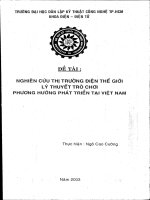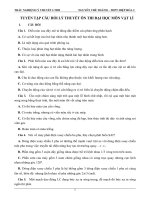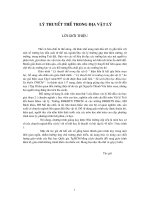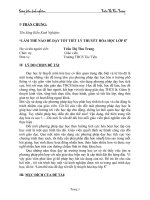THE SIMPLE PAST LY THUYET
Bạn đang xem bản rút gọn của tài liệu. Xem và tải ngay bản đầy đủ của tài liệu tại đây (105.06 KB, 5 trang )
THE SIMPLE PAST, PAST CONTINUOUS and PAST PERFECT
I. The simple past tense:
USE 1. Action finished in the past (single or repeated)
1. I met my wife in 1983.
2. Tom flew to Chicago last week.
3. Peter visited his friends in Florida two months ago.
Signal words: yesterday, 2 minutes ago, in 1990, the other day, last
Friday
USE 2. Series of completed actions in the past
1. I finished work, walked to the beach, and found a nice place to swim.
2. He entered a room, lit a cigarette and smiled at the guests.
II. The past continuous:
USE 1. The most common use of the past continuous tense is to talk
about something that was happening around a particular time in
the past.
1. At this time last week I was lying on the beach in Florida.
2. What were you doing at 8 o'clock yesterday?
3. At 6 o’clock on Saturday morning we were travelling to the airport.
USE 2. Parallel Actions: Both actions were happening at the same time.
The actions are parallel.
1.
2.
3.
4.
When Bob was painting windows, Mary was working in the kitchen.
I was studying while he was making dinner.
While Ellen was reading, Tim was watching television.
They were talking about her when she walked into the room.
USE 3. Repetition and Irritation with "Always": Expresses the idea that
something irritating or shocking often happened in the past. The concept is
very similar to the expression "used to" but with negative emotion.
1. My father was always lecturing my brother.
2. Mary was always coming to class late.
USE 4. Duration in the past:
1.
2.
3.
4.
I was riding my bike all day yesterday.
Dad was working in his garden all morning.
The nurse was sitting up with the patient all last night.
Tom was sleeping during class.
Signal words:
- From (Tuestay) to (Friday)
- All (last month/last week)
- The whole of (yesterday)
- Between….
USE 5. Polite questions: If we want to ask a polite question, we can use
the Past Continuous.
1. I was wondering if you could open the window.
2. I was thinking you might help me with this problem.
Even though the sentences have a Past Continuous form, they refer to the
present moment. Their meaning is similar to the "could you" sentences, but
they are more polite.
III. The past perfect: The past perfect is used in the same way as the
present perfect, but it refers to a time in the past, not the present.
USE 1. Completed Action Before Something in the Past: The Past
Perfect expresses the idea that something occurred before another action in
the past. It can also show that something happened before a specific time in
the past.
Examples:
1. I did not have any money because I had lost my wallet.
2. Tony knew New York so well because he had visited the city several
times.
3. When I got home yesterday, my father had already cooked dinner.
4. I arrived very late at the party. All my friends had already gone home.
5. I was very tired as I hadn't slept well for several days.
USE 2: Duration Before Something in the Past (Non-Continuous
Verbs)
We use the Past Perfect to show that something
started in the past and continued up until another action in the past.
Examples:
1. We had had that car for ten years before it broke down.
2. By the time Alex finished his studies, he had been in London for over
eight years.
3. They felt bad about selling the house because they had owned it for
more than forty years.
4. When George died he and Anne had been married for nearly fifty
years.
IV. The simple past and past continuous:
A new action happened in the middle of another action, you need
both tenses: Simple Past the new action and Past Progressive for the
action already in progress. Often, the ‘action’ described by the past
simple tense interrupts the ‘situation’ described by the past
continuous tense.
E.x.
1. While I was sitting in a meeting, (my mobile suddenly rang.)
2. When I woke up this morning it was raining and my father was
singing in the kitchen.
3. I was walking home, whistling happily, when I saw two masked men
run out of the bank.
4. I was playing a computer game when the doorbell rang.
GAMES
Once upon a time ...
Give each S a squeeky toy or something that makes a noise. This is a nice listening
activity. The T tells a story set in the past (make it up as you go along). However, make
mistakes with some of the verbs (e.g. A beautiful princess one day waked up and looked out of
her window...). Each time you make a mistake the Ss need to squeeze their squeeky toy to make
a noise and then correct the T.
Past tense mistakes
In groups, have students write past tense sentences about anything they want on
separate pieces of paper - but they have to make a mistake when writing the verb (most Ss will
really enjoy being allowed to make a mistake on purpose!). For example, "Last week I eated
curry for breakfast everyday" (Encourage crazy situations to make it fun). After writing some
sentences on different pieces of paper have the Ss swap papers with other groups and make
corrections.
Past tense slap
A very simple activity. Ss are put into teams. The teacher either shows a verb flashcard
or says a verb in the infinitive and the Ss have to slap the table if they know the past tense
version (e.g. T: "Throw", S: "Threw"). The T asks the S who slapped the table first to give
his/her answer to win a point for their team.
The last time I ...
Ss sit in a circle with a pile of action flashcards, face down, in the middle. S1 picks up a
card and makes a sentence using the structure, "The last time I ___ was (time expression)" E.g.
The last time I played tennis was last summer. The last time I watch TV was yesterday evening.
The last time I cooked was 4 days ago, etc. If the sentence is perfect the S keeps the card and
scores 1 point. If not, the card is returned to the pile.
Yesterday I went to ...
This is a chain game, like the game "I went to the market and bought ___". T sits in a
circle with the Ss. The T starts by saying "Yesterday, I went to the supermarket and bought
some bread". Then S2 will have to repeat that sentence and add his/her own, e.g. "Yesterday, I
went to the supermarket and bought some bread, then I went to the movie theater and watched a
movie". Then S3 repeats these two sentences and add his/her own e.g. "Yesterday, I went to the
supermarket and bought some bread, then I went to the movie theater and watched a movie,
then I went to a cafe and drank a Coke" ,etc. If a S forgets something he/she sits out that round.
Yesterday Time Guess
On 12 small squares of paper write down key hourly times (e.g. 6am, 7am, 12pm, 4pm,
6pm, etc.). Also include a few "wild cards" with a question mark written on them. Fold the
squares of paper and put into a small box. Ss sit around the box and take turns on taking out a
piece of paper. They have to make a sentence based on what they did yesterday using the
structure, "Yesterday, I was ___ing at ___ o'clock" (E.g. Yesterday, I was sleeping at 6 o'clock in
the morning, Yesterday, I was eating dinner at 6 o'clock in the evening, etc.). If a S picks a wild
card they can make a sentence about any time of the day. If the student makes a perfect sentence
they keep the piece of paper, if not it goes back into the box. The person with the most pieces of
paper at the end is the winner.









